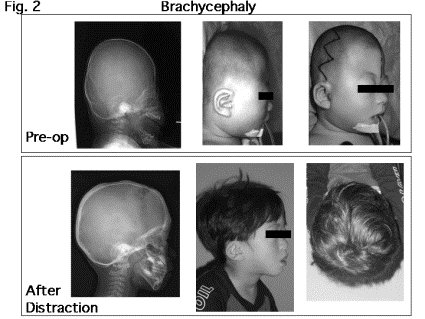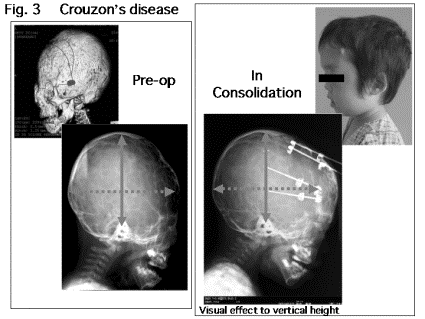Sunday, October 10, 2004 - 2:00 PM
5671
Cranial Vault Distraction: Its Illusionary Effect and Limitation
Compared with the classic subtotal or total calvarial remodeling procedure, distraction osteogenesis (DO) has some advantages, such as less hazardous complications, less scaring, and fewer bone defects. However, DO has not yet been fully accepted. Since DO is only a unidirectional expansion along the distraction devices, it has been thought that secondarily affected distortions (compensative deformity: e.g., vertical height in turricephaly) remain unsolved.
BACKGROUND: Before 1999, the radical reshaping procedure was the first preference for the surgical treatment of craniosynostosis in our department. However, some patients suffered from severe operative blood loss, epidural dead spaces, and/or postoperative infections. Furthermore, since cranial expansion was limited by scalp tension as well as soft tissue scaring, undercorrection of the cranium and a relapse of the vault deformities were occasionally complained after long-term follow-up. The problem with these patients was their bone defects, which made cranial revisions more complicated. (Fig. 1) We have employed DO and noticed that, after a unidirectional expansion without vertical reduction, the shape of the cranium improved satisfactorily, which might have resulted from both an illusional effect because of the relative reduction compared to the elongation by DO and, in bracycephaly, alteration of patient's head position due to inclination of facial plane by forehead advancement.
MATERIALS & METHOD: Twelve cases of craniosynostosis were treated with DO. Five patients were syndromic (two cases of Pfeiffer's syndrome, two of Crouzon's disease, one of Apert's syndrome), and seven were non-syndromic (four cases of bracycephaly, two of scaphocephaly, one of plagiocephaly). The mean age of patients was 2.9 years and ranged from 6 months to 13 years. In accordance with the desired osteotomy lines based on pre-operative planning, the calvarium was osteotomized using a fine craniotomy bar, and subsequently attached with distraction devices with maintaining the underlying dura mater attached to the segments. Distraction was initiated 5 days postoperatively, and was performed twice per day (approximately 0.5 mm per activation) till the desired expansion was achieved. Consolidation periods were 4 to 6 months after the completion of distraction. The follow-up length ranged from 10 months to 4 years 8 months.
RESULTS & DISCUSSION: None of the DO patients sustained any severe complications such as meningitis and all patients were stable during the hospitalization period. In the case of brachycephaly patients, the skull shape substantially improved because the vertical height appears to be reduced only after fronto-orbital advancement, which could be attributed to the relative and visual effects caused by the advancement. (Fig. 2) Furthermore, the alopecic scar was not so conspicuous as compared with conventional reshaping. Similarly, in syndromic cases, only the advancement immediately after the distraction, prior to removal of the devices, succeeded in making the patient's skull shape proportional. (Fig. 3) This indicates that the effect on the vertical height must not depend on remodeling of the cranial bone with growth. However, in scaphocephaly, the unique deformity in the occipital and frontal region remained after simple distraction. In the case of asymmetric deformity without a narrow cranium, for example, resulting from the plagiocephaly, conventional cranial reshaping should have been the first preference, because of the adequate bone graft and less epidural dead space as well as less tension at skin closure.
CONCLUSIONS: Revision of compensative deformity does not seem to be essential because DO could expand the affected deformity enough without considering the direct skin closure. Therefore, we propose that DO should be applied for a narrow cranium because bone defect and scalp closure could pose problems in such a case. Direct reshaping should be used in cases of sufficient donor bone and scalp closure. Although additional surgery is unavoidable for device removal, minor revisions can be performed for shaving the irregularity at that time. Except for prolonged treatment, based on minimally invasive surgeries, DO might be applied extensively in the cases of craniosynostosis than thought previously, if surgical techniques and distraction devices were further improved.
View Synopsis (.doc format, 427.0 kb)
See more of Cranio/Maxillofacial/Head & Neck
Back to 2004am Complete Scientific Program



